An excellent variety for lovers of large-fruited sweet tomatoes - the Pink Giant tomato.
Fans of large-fruited tomatoes will appreciate the Pink Giant variety with an average weight of 400 g per fruit. Those who love sweet, juicy tomatoes, which make delicious salads, juices and sauces, will also be interested in it. In this review, we will tell you how to get a large harvest of Pink Giant and what mistakes you should avoid when growing this variety of tomatoes.
Description of the variety
The variety was bred by breeders of JSC Scientific and Production Corporation NK.LTD (Shchelkovo). In 2002, the Pink Giant was included in the state register Russian Federation as a variety intended for cultivation in greenhouses and open ground. This allows tomatoes to be grown in all regions of the country.
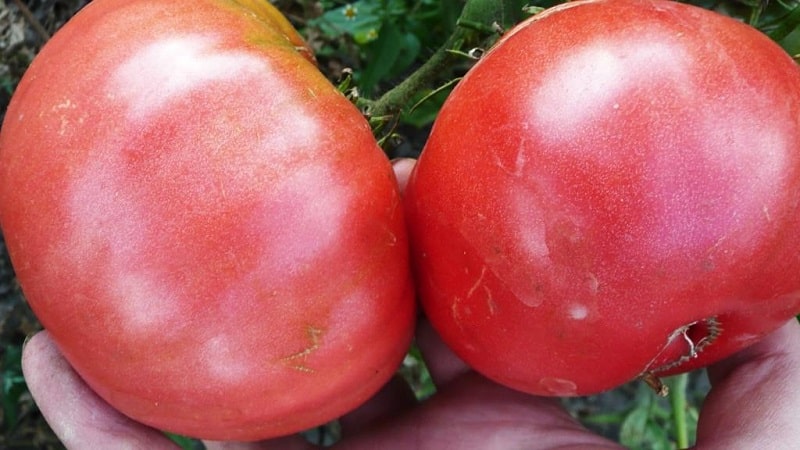
Distinctive features
Indeterminate, mid-season variety. The fruit ripening period is 105-115 days from the appearance of the first shoots. As you can see in the photo, the bush is tall - 1.5-2 m, medium-leaved, but with large, potato-like leaves, which is why it needs a mandatory garter. Each plant produces 6 clusters, each with 3 to 6 ovaries.
Fruit characteristics, yield
The color of the tomato is pink. Tomatoes have the following properties:
- sweet, fleshy, juicy pulp;
- ribbing (at the stalk);
- seed chambers are slightly expressed, with a small number of seeds;
- round, slightly flattened shape.
Productivity - 12 kg per 1 sq. m. The weight of one fruit is 400 g, and, subject to certain conditions, reaches 1 kg.
How to grow seedlings
Seeds for seedlings are sown in early March. In the south of Russia, tomatoes are also planted using the “seedless method” - the seeds are sown directly into the beds.
Seed preparation
To begin with, gardeners calibrate the seeds. Select large (and medium-sized), even grains that are not empty to the touch.
Selected seeds are placed in a saline solution, for the preparation of which a tablespoon of salt is stirred in a glass of water. After 15-20 minutes, the container is checked: the seeds that have sunk to the bottom are selected for planting.
The seeds are laid out on a cotton cloth and placed on a central heating radiator for 36-48 hours to warm up.
After the grain is disinfected in a 1% solution of potassium permanganate. To do this, dissolve a teaspoon of potassium permanganate in three glasses of water. The duration of the procedure is 15-20 minutes, then the seeds are washed with clean running water.
Interesting! If there is no potassium permanganate, summer residents use hydrogen peroxide. Dissolve 1 tbsp in 400 g of warm (+40 °C) water. l. 3% peroxide and place the seeds in the solution for 12 hours. This method accelerates germination, but is not suitable for coated seeds (with a nutrient coating) and encrusted seeds (with a thin water-soluble layer containing disinfecting and growth-stimulating components).
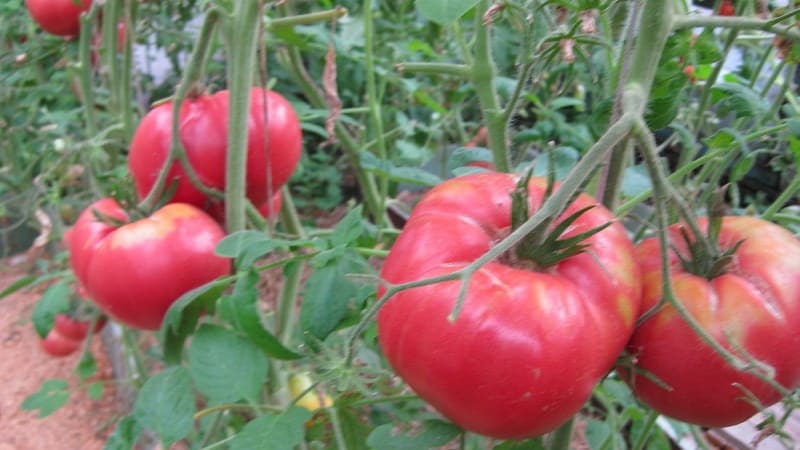
The seeds are saturated with oxygen - bubbled. To do this, they are placed in warm (+26…+30 °C) water and stirred every hour for 15-18 hours. Some gardeners use an aquarium compressor for this procedure. Bubbling is beneficial for grains: it increases their germination and the viability of the resulting seedlings.
Read also:
Salad tomato “Pink Elephant” and its benefits
Next, the seeds are soaked for 12 hours. in water or a solution of biostimulating drugs:
- "Zircon".
- "Epin."
- "Immunocytophyte".
The water when soaking must be at least +21 °C.
The next stage is hardening. The seeds are wrapped in cloth and polyethylene and placed in a place with a temperature of -2...+3 °C for 8 hours. Then return to heat for 8 hours. Carry out 5-6 changes in temperature conditions.
Important! Summer residents who harden planting material note that this procedure is complicated, and if done incorrectly, there is a risk of spoiling the seeds.
Before planting, the seeds are germinated by placing them on cotton cloth or gauze on a flat dish.. The fabric is constantly moistened with warm (+25…+30 °C) water until embryos of 2-3 mm in size appear.
Container and soil
Take as a container for planting plastic containers, cups, cut PET bottles.
You can buy the soil at the store or prepare it yourself. The purchased mixture must include:
- humus;
- peat;
- river sand.
To prepare the soil for tomato seedlings yourself, connect:
- 1 part of garden soil (it is better to take it from the area where cucumbers, zucchini, carrots, and dill grew);
- 2 parts non-acidic peat (pH 6.5);
- 0.5 parts sand (river or washed);
- 1 part humus or sifted mature compost.
Add sifted wood ash (or dolomite flour), sphagnum moss and fallen pine needles.
Containers and soil are disinfected boiling water or a solution of potassium permanganate.
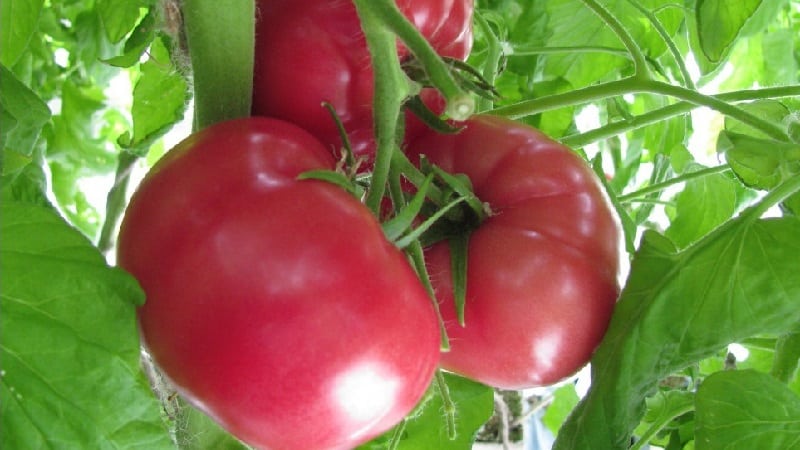
Sowing
The pink giant is not dived, but immediately placed in separate cups. Picking inhibits the development of the plant, and the fruits will begin to form 1-2 weeks later. 3-4 grains are planted in one container, after the appearance of cotyledon leaves on each plant, the strongest tomato is selected, and the rest are removed.
Seeds are dropped 1 cm deep, the soil is moistened with a spray bottle.. The containers are covered with film and placed in a warm (+23 °C), bright place.
Interesting! Tall tomatoes need strong roots. The development of the root system is improved with the help of eggshells and dry banana peels. They are crushed and placed at the bottom of containers for seedlings.
Growing and care
As soon as the seeds sprout, remove the film. Water the seedlings as the soil dries using a syringe, teaspoon or sprayer so as not to wash out weak seeds and roots.
The variety is light-loving, so containers are placed on southern windows or illuminated with lamps (use special and ordinary fluorescent lamps).
Important! If there is not enough light, the seedlings stretch upward and may break.
Every two weeks, seedlings are fertilized with complex fertilizers. 2-3 weeks before transplanting to the beds, the seedlings begin to be taken out into the open air: balcony, summer veranda. First for 2-3 hours, and every subsequent day an hour is added. 3-4 days before moving to a permanent place, the seedlings are left to spend the night outside (if there are no night frosts). This allows the plants to acclimate to lower temperatures and direct sunlight.
How to grow tomatoes
Seedlings are planted in the ground 60 days after emergence. By this time, the plant will have 6-7 leaves and one raceme with an inflorescence.
Landing
Good predecessors for tomatoes are cucumbers, zucchini, dill and carrots., but in the area where tomatoes, potatoes and peppers grew, tomatoes are not planted - the plants are susceptible to the same diseases and suffer from the same harmful insects. Before planting, the soil is disinfected with boiling water or a solution of potassium permanganate.
The pink giant is planted with a ball of earth, trying not to damage the roots. The planting pattern is 70x70; with more frequent planting, the plant’s yield decreases.
Care
Tomatoes are watered with warm water only at the root, avoiding water getting on the stem and leaves.. After watering, weed and loosen the soil. Fertilizers are applied every 2 weeks, alternating complex and mineral fertilizers.
Summer residents form giant tomatoes with one, two and three stems. However, the more stems, the smaller the fruits.
The bushes grow tall, so they are tied up. Sticks, ropes or a trellis are used as support.
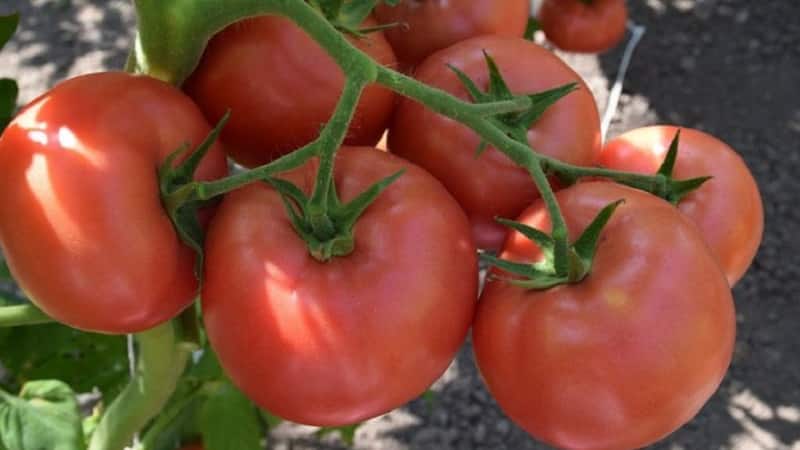
Rules for pinching the Pink Giant:
- The maximum number of brushes is 7. Otherwise, the tomatoes will not have time to ripen before frost.
- A bush pinched after 4-5 flowers will produce larger fruits.
- Very large fruits (up to 1 kg) are obtained by leaving 3 inflorescences in the cluster.
Features of cultivation and possible difficulties
Large-fruited tomatoes are fed throughout the season, especially during the formation of inflorescences and fruit set.. In addition, they need more water to form fruits, so watering is carried out more often, but not abundantly. To preserve moisture in the soil (and reduce the frequency of watering), gardeners recommend using mulch - spreading hay, straw, and sawdust between the bushes.
Not only the stem is tied up, but also each brush separately.
All stepsons are gradually removed and leaves up to the first flower cluster.
Diseases and pests
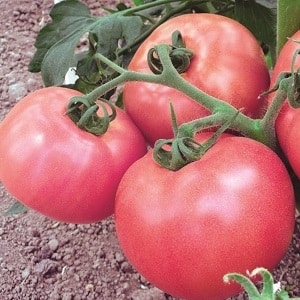 Pink giant tomatoes have average immunity to diseases. Fungal diseases develop in tomatoes in greenhouses. To avoid this, gardeners thoroughly ventilate shelters and treat:
Pink giant tomatoes have average immunity to diseases. Fungal diseases develop in tomatoes in greenhouses. To avoid this, gardeners thoroughly ventilate shelters and treat:
- "Fitosporin".
- "Ekosilom".
- "Quadris".
- "Ridomil Gold".
Important! To prevent phytosporosis, farmers use whey (with a fat content of no more than 1%, so as not to burn the leaves). Immediately after transplanting the seedlings into the ground, the bushes are sprayed with this product. The procedure is repeated every 10 days.
Pink giant tomatoes are attacked by harmful insects such as aphids and thrips. They are fought with the help of the drug “Zubr”. “Prestige” will save you from the Colorado potato beetle, and “Confidor” from the whitefly.
It will be interesting:
The nuances of growing in open ground and in a greenhouse
Tomatoes are planted in open ground at the end of May and only in the southern regions of Russia, but even in this case, in the first 2 weeks it is recommended to cover the plants with agricultural material at night.
Planted in a greenhouse at the end of April (southern regions) - beginning of May (middle zone and north of the Russian Federation). When growing in greenhouse conditions, make sure that it is not too hot and ventilate regularly. Install the shelter so that in the afternoon the tomatoes are not exposed to active sunlight.
In a greenhouse, summer residents recommend forming a tomato into one stem, in open beds - at two.
Harvesting and application
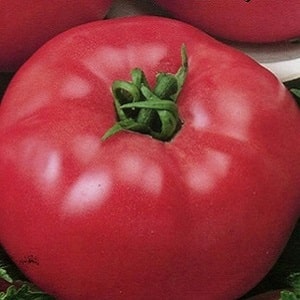 The first fruits are plucked from the bush 105-115 days after emergence. Productivity – 12 kg per 1 sq. m (from three bushes). When forming into one stem, fewer tomatoes are harvested, but each fruit is larger in volume and weight (up to 1 kg), and with 2 and 3 stem formation, more fruits grow on the bush, but are smaller in size (300-500 g).
The first fruits are plucked from the bush 105-115 days after emergence. Productivity – 12 kg per 1 sq. m (from three bushes). When forming into one stem, fewer tomatoes are harvested, but each fruit is larger in volume and weight (up to 1 kg), and with 2 and 3 stem formation, more fruits grow on the bush, but are smaller in size (300-500 g).
The variety is classified as a salad variety, so tomatoes are consumed fresh.. Juicy tomatoes are suitable for making juice, sauces, ketchups and snacks. Due to the large size of the fruit and delicate skin, it is not used in pickling.For the same reason, tomatoes do not tolerate transportation and long-term storage.
Advantages and disadvantages of the variety
The main advantage of the Pink Giant is its large fruit size.. In addition, tomato fruits are juicy, sweet and tasty.
It is for the “real” tomato taste that the giant’s shortcomings are forgiven:
- Picky about weather conditions (does not tolerate heat, frost, or direct sunlight).
- Requires time and effort to care (frequent but not abundant watering, regular feeding throughout the season, shaping, pinching and tying not only the stem, but also the brushes).
- Impossibility of long-term storage, transportation (delicate thin leather cracks during transportation).
Farmer reviews
Farmers note the taste, size of tomatoes and long - until the first frost - fruiting.
Dmitry Ivanov, Kaluga: “This is the second year I’ve been growing Pink Giant in a greenhouse. The taste is excellent. Some fruits crack in the stem area. The cracks darken and spoil the appearance, but the taste does not suffer because of this.”.
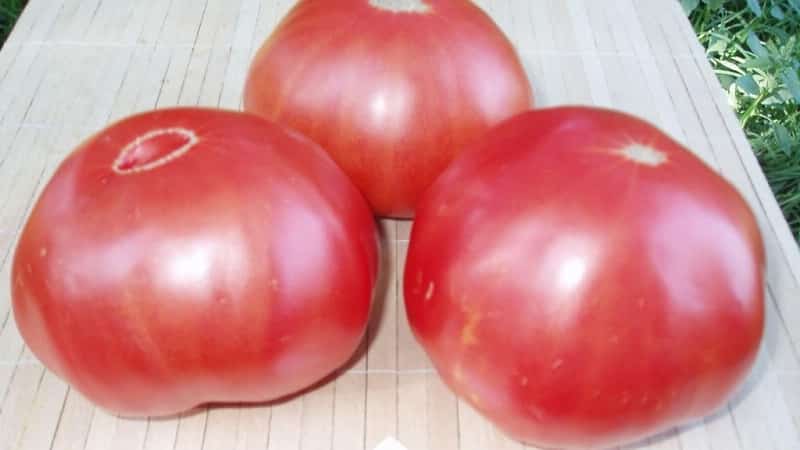
Anna Vasina, Stary Oskol: “I always grow Pink Giant tomatoes from my own seeds. During the outbreak of the epidemic, the bushes were affected by late blight. Tomato shoots tend to take root quickly. By autumn, a normal new bush grows out of them, and before frost I pick delicious tomatoes.”.
Mikhail Drozd, Moscow region: “Pink Giant is my favorite variety; I have been growing it in a greenhouse for several years. Fruits almost until the first frost. It does not ripen very quickly, the lower fruits are simply gigantic, but the upper ones cannot be called small either. When ripe, tomatoes are dark pink. We use tomatoes in preparations, eat them fresh, the taste is wonderful.”.
Igor Pronin, Samara: “I grow the Pink Giant variety as seedlings and plant them in the garden.The tomatoes have never been seriously ill. There are always plenty of fruits and they are delicious. But with watering you need to guess. The plant loves water, but excess moisture causes the fruits to partially crack.”.
Conclusion
Tomatoes are suitable for growing in central and southern Russia. In the first case, greenhouses are used, and in the second, open beds are used. Despite the difficult care, the Pink Giant tomato continues to be popular among Russian summer residents. The reason for this is the sweet taste, large fruit and productivity of the variety.
The variety is not suitable for growing for sale - due to improper watering, the fruits crack and, not yet picked from the bush, already lose their marketable appearance, and the thin skin does not allow the tomatoes to be transported.
Pink giant is one of the best salad varieties: soft and juicy; tomatoes are used to make juice and sauces, but they are not suitable for canning due to the large size of the fruit and the thin, delicate skin that cracks when heated. There is no need to buy seeds every year: many farmers plant tomatoes from the seeds of last year's fruit. One large tomato yields 80-100 grains.